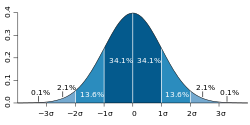Percentile
A percentile (or a centile) is a measure in statistics.
It is a way of expressing where an observation falls in a range of other observations.
For example, if a score falls in the 20th percentile, this means that 20 percent of all the scores recorded are equal to or lower. If a score is in the 90th percentile, this means that 90 percent of all the other scores were equal to or lower than that score.
In statistics, percentiles are found by taking a large set of numerical data, arranging it in ascending order, and then dividing it into 100 groups with an equal number of data points. Each of the 99 dividing points is called a percentile of the data set.
Some of the percentiles have special names. For example. the 25th, 50th and 75th percentiles are called the first, second and third quartile, respectively.[1] The 50th percentile is also called the median.
Percentile Media
Representation of the three-sigma rule. The dark blue zone represents observations within one standard deviation (σ) to either side of the mean (μ), which accounts for about 68.3% of the population. Two standard deviations from the mean (dark and medium blue) account for about 95.4%, and three standard deviations (dark, medium, and light blue) for about 99.7%.
Related pages
References
- ↑ "Percentiles". www.mathsisfun.com. Retrieved 2020-10-13.


